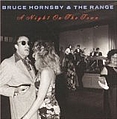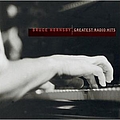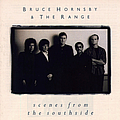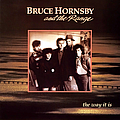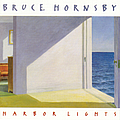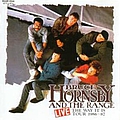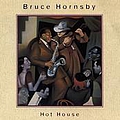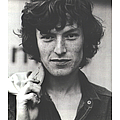Bruce Hornsby & The Range Biography
Bruce Randall Hornsby (born November 23, 1954 in Williamsburg, Virginia) is an American singer, virtuoso pianist, accordion player, and songwriter, best known for his 1980s signature song "The Way It Is", the top five hits "Mandolin Rain" and "The Valley Road", and for being a recurring collaborator with the Grateful Dead. Hornsby is the second of three sons born to Lois (Saunier) and Robert S. Hornsby, who was a successful oil and real estate executive in Williamsburg, Virginia. The other sons, Robert "Bobby" Jr., and Jonathan, are highly regarded musicians in their own right. Hornsby grew up listening to all types of music. He studied music at the University of Richmond, as well as the highly regarded Berklee College of Music and the University of Miami, from which he graduated in 1977. In the spring of 1974, Hornsby's brother Bobby, who was a brother of the Beta Theta Pi fraternity at the University of Virginia, formed a band, "Bobby Hi-Test and the Octane Kids" to play fraternity ragers, featuring Bruce on Fender Rhodes and vocals. "We used to play college grain-alcohol parties," remembers Hornsby. "We did a little Allman Brothers, a little Band, but almost all Dead. We used to do 'Jack Straw', 'Sugar Magnolia', 'Truckin',' 'Not Fade Away', 'Goin' Down the Road Feelin' Bad'...lots of Europe '72 and Skull and Roses. We didn't do a whole lot of money gigs, but it was more about just going to this country house that my brother lived in with all these hippies, and sitting around playing."[1] Following his graduation from the University of Miami, Hornsby spent time in Los Angeles as a session musician and songwriter before moving back to his native southeastern Virginia In 1984 he formed Bruce Hornsby and the Range, who were signed to RCA Records in 1985. Besides Hornsby, Range members were David Mansfield (guitar, mandolin, violin), George Marinelli (guitars and backing vocals), Joe Puerta (bass guitar and backing vocals), and John Molo (drums). Hornsby's recording career started with the biggest hit he would ever have, entitled "The Way It Is". With a propulsive yet contemplative piano riff and the refrain, That's just the way it is, some things will never change, the song was both catchy and reflective of the American Civil Rights movement, and it topped the American music charts in 1986. In years to come, the song would be sampled by at least six rap artists, including Tupac Shakur, E-40, and Mase. It is also used as some of the introductory music to Sean Hannity's popular talk radio program. With the success of the single worldwide, the album The Way It Is went multi-platinum and produced another top five hit with "Mandolin Rain" (co-written, as many of Hornsby's songs were, with his brother John). "Every Little Kiss" also did respectably well. Other tracks on the album helped establish what some labeled the "Virginia sound", a mixture of rock, jazz, and bluegrass with an observational Southern feel. Hornsby and the Range would go on to win the Grammy Award for Best New Artist in 1987. The wave of fame continued to roll with Hornsby and the Range's second album, Scenes From The Southside (on which Peter Harris replaced Mansfield). Released in 1988, it featured such hits as "Look Out Any Window" and "The Valley Road". The song "Jacob's Ladder" was featured as well, having originally been written by Hornsby for musician friend Huey Lewis. Lewis' version became a number one hit from his album Fore!. Scenes was successful in its own right and it would also be the last to perform so well in the singles market. In 1988, Hornsby first appeared on stage with the Grateful Dead, lending some assistance to that group's somewhat unstable keyboards position, in this case following the death of Brent Mydland and preceding the incorporation of Vince Welnick as full-time keyboardist. Hornsby played piano (and occasionally the accordion) nightly with the Grateful Dead from September 1990 through March 24, 1992. He co-composed the song "Silver Apples of the Moon" for the Grateful Dead's Infrared Roses. This collaboration would continue on an less regular basis until the Grateful Dead ended in 1995; in all he made several hundred appearances with them. In 1989 Hornsby co-wrote and played piano on Don Henley's big hit "The End of the Innocence". In 1991 Hornsby played piano on Bonnie Raitt's popular hit "I Can't Make You Love Me". Hornsby would feature both these songs in his own concerts. A Night On The Town was released in 1990. A change in style became apparent as the album was much more guitar driven, while the others were centered around Hornsby at the piano. After the album, the Range broke up with each member pursuing respective musical careers. Hornsby would go on to release his first solo album, Harbor Lights, in 1993. This record showcased Hornsby in a more jazz-oriented setting and featured an all-star lineup, including Pat Metheny, Branford Marsalis, Jerry Garcia, Phil Collins, and Raitt. The tone was set by the opening title track, which after 50 seconds of expansive Virginia sound solo piano (written and recorded by Hornsby after the rest of the track was finished, because, as Hornsby would later say, he thought it would make a good opening to the album) lurches into an up-tempo jazz number, ending with Metheny's guitar runs. The album closes the same way on "Pastures of Plenty", this time with Garcia intertwined with Hornsby's piano. The mid-tempo "Fields of Gray", written for Hornsby's recently-born twin boys, received some modest radio airplay. Harbor Lights was well-received by critics and fans, but Hornsby acknowledged that his days of popular commercial success were behind him, saying in interviews that it had been an accident that his McCoy Tyner-influenced piano work ever found itself in the middle of a hit record in the first place.. In 1995, Hot House was released. The jazz feelings that peppered the previous album would be expanded on here, giving the album a constant uptempo party sound. As is typical with Hornsby, the underlying messages behind the catchy tunes are often very dark, such as on "Country Doctor" and "White Wheeled Limousine". Murder, nuclear disaster, adultery: these dark themes and more can be found in many Hornsby compositions. (Interestingly enough, the song "White Wheeled Limousine" had debuted five years earlier as an encore to Branford Marsalis's opening act for the Grateful Dead's 1990/91 New Year's Concert, Marsilis and Rob Wasserman joined Hornsby in the performance). The album also makes an homage to Hornsby's years with the Dead via his recasting of the instrumental bridge of the Dead's song "Estimated Prophet" as the newly-lyricized Hornsby tune "Tango King." The album featured many of the same guests as on his previous record, such as Pat Metheny, and added folk music to Hornsby's usual mix. Bela Fleck also collaborates again on banjo, having previously appeared on A Night on the Town. The album also boasts more prominent roles for Harbor Lights alums John D'earth on trumpet and Bobby Read on woodwinds, and Read continues to perform with Hornsby to this date. Three years later, Hornsby released a double album, Spirit Trail. Featuring a decidedly goofy picture of his uncle on the cover, the collection blends instrumental tracks with the story-telling, rock, jazz, and other musical forms Hornsby had delved into over his career. Among other homages, the song "Sunflower Cat, Some Dour Cat, Down With That" samples and loops the main lick from the Dead song "China Cat Sunflower." Hornsby's piano playing gained further complexity here, as evidenced by his two-hand-independence on such tracks as "King of the Hill," and prompting Hornsby's devoted fanbase to not only request songs at concerts (a long time Hornsby feature at live shows) but to begin requesting "two-hand-independence". Hornsby next worked with several Grateful Dead reformation projects, including several Furthur Festivals and the ultimate formation of The Other Ones, which resulted in the release a live album. Hornsby's own touring band line up underwent extensive change during this period as well, not the least of which was the apparent end of musical collaboration with long time drummer John Molo. As Hornsby experimented with a different sound, ushering in frequent collaborations with such musicians as Steve Kimrock on guitar and Bobby Read on heavily effects-driven electronic woodwinds, his current band, dubbed The Noise Makers, took shape. In 2000, Hornsby chronicled this journey with a compilation live album entitled Here Come The Noise Makers, and did extensive touring. It would not be until 2002 when he would release another album of new material, entitled Big Swing Face. Hornsby wanted to experiment and did so by dropping the piano almost completely in favor of electric pianos and other synthesizers. "Big Swing Face" also evidences a greater reliance upon programmed loops than most of his prior work, as well as lyrics that are in many ways more eccentric and humorous. Although the album marks perhaps Hornsby's most experimental work, including the track "Stick and Stones" which Hornsby cites as his partial homage to Radiohead's "Everything in its right place," the album was not well-received by many and was poorly promoted by RCA, perhaps prompting Hornsby's decision to leave the label. However, in 2004, after 19 successful years on RCA Records, Hornsby returned to a more acoustic, piano-driven sound on his Columbia Records debut Halcyon Days. Guests included Sting, Elton John, and Eric Clapton. With no signs of slowing down yet, Bruce Hornsby remains a musician more concerned with his devoted fan base and his own growth as an artist than with commercial success. In July 2006, Hornsby released a box set titled Intersections {1985-2005} to celebrate two decades of his music. The set contains 4 audio CDs containing some pre-released songs and many new songs and recordings from concerts. Much of the music contains collaborations with such artists as The Nitty Gritty Dirt Band, Chaka Khan, and Branford Marsalis. The set also includs a DVD containing music videos and video recordings of several songs. All ticketholders on Hornsby's 2006 tour receive a free copy of this set. Hornsby also has worked with many other artists over the years, including Sheena Easton, Squeeze, Warren Zevon, Chaka Khan, Stevie Nicks, Béla Fleck, Steve Kimock and others. He continues to work with Dead-related projects, such as Bob Weir's Ratdog and The Other Ones, and in 2005 participated in a tribute concert to Jerry Garcia. Hornsby has also taken an ownership interest in Williamsburg area radio station "The Tide", WTYD 92.3 FM, so that (he said) his music could be heard on the radio in his hometown. Accordingly, his Brunch with Bruce program, where he plays selections from his concerts, is heard on Sunday mornings. Hornsby began a solo tour October 2, 2006 which is scheduled to end February 5, 2007 in Bend, Oregon.
Top Bruce Hornsby & The Range Lyrics
Write a comment
What do you think about Bruce Hornsby & The Range? Let us know in the comments below!
Bruce Hornsby & The Range Albums
Similar artists
- Bruce Hornsby80s/Pop/Rock
- Don Henley80s/Rock
- Steve Winwood80s/Pop/Rock
- Mr. Mister80s/Pop/Rock
- Marc CohnPop/Rock
- Dan FogelbergFolk
- Steve Perry80s/Rock
- Glenn Frey80s/Rock
- Bonnie RaittBlues/Country/Rock
- John Waite80s/Pop/Rock







